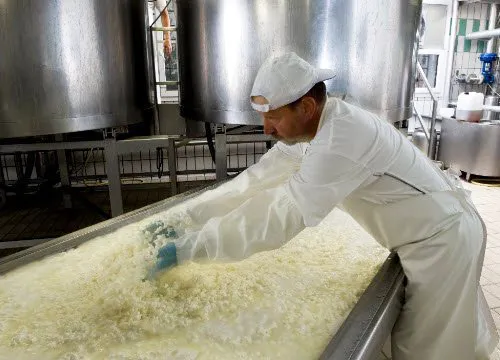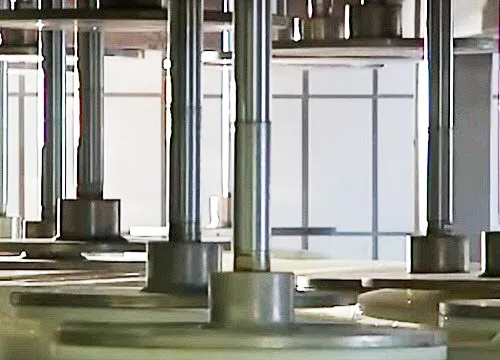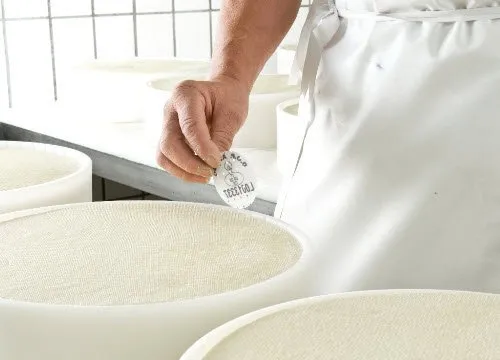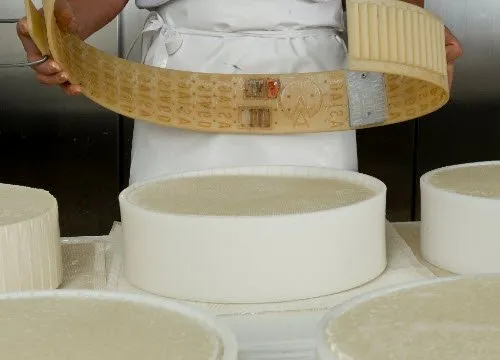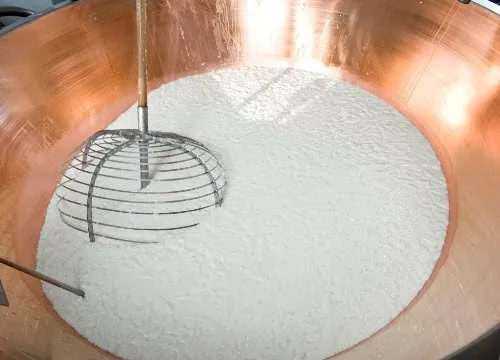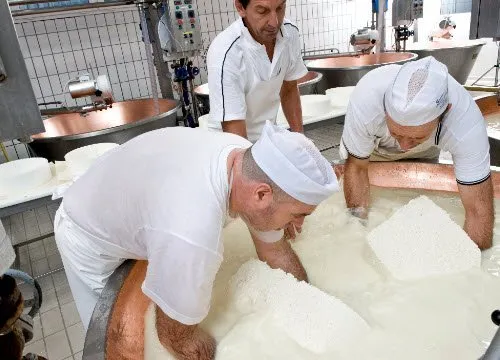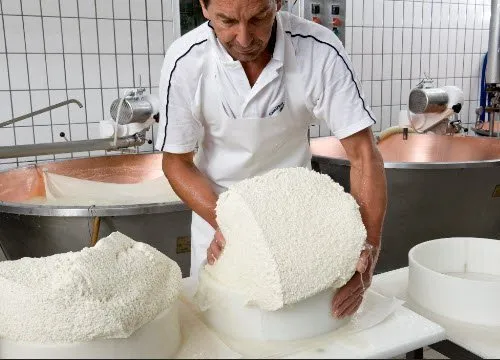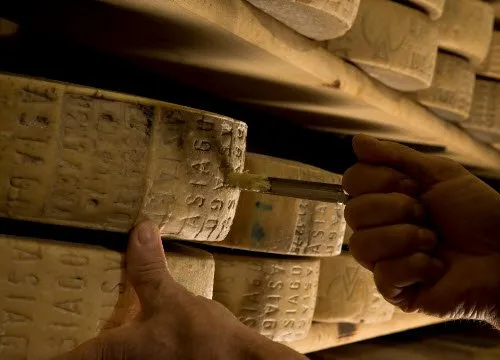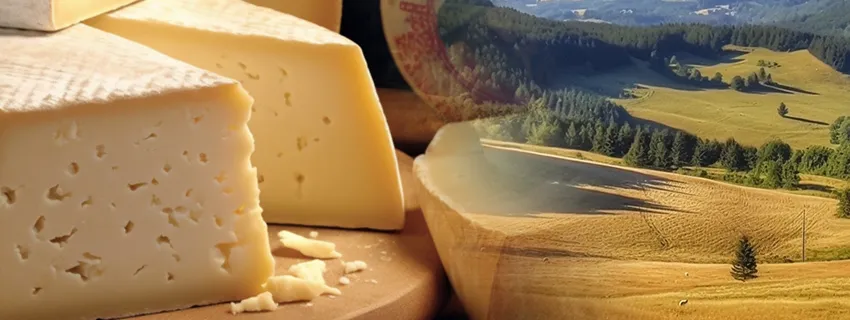Published:
Author: Antonio Maria Guerra
How Is Asiago Cheese Made?

How is Asiago cheese made? Let’s find out how one of the most popular Italian dairy specialties, the fruit of a millenary tradition, is produced, starting from the milk, up to its aging.

How is Asiago cheese made?
The methods to produce the Asiago cheese slightly change according to the type.
Here follows a list of the various steps necessary for each of these two methodologies (click here to view a printable infographic of the procedure):
‘Fresh’ Asiago (also known as ‘pressed’ Asiago).
Fresh Asiago is produced using whole milk.

01. The milk is heated, bringing it to a temperature of 35°C;

02. Bovine rennet is added to the heated milk (*1). The ‘curd’ takes form (*2);

03. The curd is broken into fragments the size of a walnut (*3);

04. The curd is cooked in two phases, the first at 40°C, the second at about 44°C.;

05. The ‘serum’, the liquid in which the curd is immersed, is drained;

06. The curd is salted, cut and mixed by hand;

04. The paste thus obtained is poured into molds, where it is pressed (*4) for a few hours;

05. The paste is placed in a ‘marking mold’ (*5) which stamps the mark on its side (*7);

06. The cheese wheels are seasoned for about 20/40 days;
‘Seasoned’ Asiago (also known as ‘Asiago d’Allevo’).
Seasoned Asiago is produced using the milk obtained from two milkings, one of which is skimmed.

01. The milk is heated, bringing it to a temperature of 35°C;

02. Bovine rennet is added to the heated milk (*1). The ‘curd’ takes form (*2);

03. The curd is broken into fragments the size of a grain of rice using the ‘spino’ (*6);

04. The curd is cooked in two phases, the first at 40°C, the second at 47°C;

05. The ‘serum’ is drained. The resulting paste is poured in a special mold (*5);

06. The paste is placed in a ‘marking mold’ (*5) which stamps the mark on its side (*7);

07. The cheese is immersed for a few days in brine: this way it’s salted;

08. The cheese wheels begin an aging process that can last many months;
Notes:
*1: Animal ‘rennet’ (there are other types) is a digestive enzyme extracted from the stomach of calves, goats or very young pigs;
*2: ‘Curd’ is obtained by adding rennet to warm milk: this brings to the coagulation of the casein present in the milk itself and the formation of a gelatinous mass;
*3: This size, however small, is still much greater than that required for the production of ‘fresh’ Asiago;
*4: Hence the name ‘pressed’ (pressato), often used for fresh Asiago;
*5: These special molds are called ‘fascere’: they are foldable bands used since ancient times in Asiago to give to the local cheese the cylindrical shape. In the past they were made of wood, nowadays they are usually made of plastic;
*6: Operation carried out thanks to a particular instrument known as ‘lira’ or ‘spino’;
*7: The ‘scalzo’ is the side of the cheese wheel;
Let’s find out the fascinating origins of Asiago cheese, its types and a large number of information and tasty curiosities. Click this LINK to read the article.
How is Asiago cheese made? Printable infographic.
Click HERE to view (and, eventually, download) a printable infographic showing the steps necessary to produce Asiago Cheese.

Asiago ‘Product of the Mountain’.
When Asiago cheese is produced at an altitude of at least 600 meters gets the title ‘Product of the Mountain’: this characteristic is highlighted by a specific symbol marked on the side of the wheels.

Asiago Stravecchio at the end of a meal.
One of the best ways to enjoy a slice of Asiago Stravecchio is to dip it in honey or jam. Another good way is to accompany it with some ‘passito’ wine: this combination gives to the palate unique sensations.

Asiago cheese: calories & nutritional values.
Here follows a list of the main nutritional values of Asiago:
- Good content of proteins, higher than that present in the same quantity of meat. Their presence increases with cheese aging;
- Abundant content of sodium: its presence increases with cheese aging;
Read more
- Abundant content of lipids: their presence decreases slightly with cheese aging;
- Abundant cholesterol content;
- Lastly, it contains calcium, phosphorus and the vitamins A, B, B2 (riboflavin);
The quantity of calories in Asiago cheese depend on its seasoning:
- Fresh Asiago cheese: 368 Kcal for 100gr.;
- Seasoned Asiago cheese: 382 Kcal for 100gr.;

Consorzio Tutela Formaggio Asiago: contacts.
This article is the result of the collaboration with the Consorzio Tutela Formaggio Asiago: organization gathering the most traditional producers of the specialty.
Official website: www.asiagocheese.it
Mail: info@formaggioasiago.it
Tel.: +39 0444 321758
Copyright information.
The images displayed in this page belong to WebFoodCulture and to the Consortium for the Protection of Asiago Cheese.

